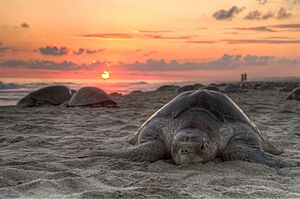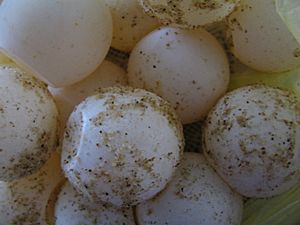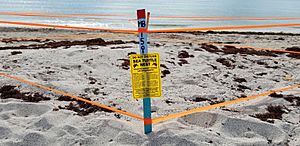Sea turtle facts for kids
Quick facts for kids Sea Turtles |
|
|---|---|
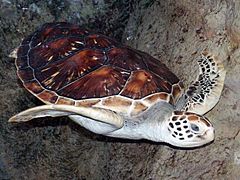 |
|
| Sea turtle | |
| Scientific classification | |
| Kingdom: | |
| Phylum: | |
| Class: | |
| Order: | |
| Suborder: | |
| Superfamily: |
Chelonioidea
Bauer, 1893
|
| Genera | |
|
|
Sea turtles (Chelonioidea) are turtles found in all the world's oceans except the Arctic Ocean, and some species travel between oceans. The term is US English. In British English they are simply called "turtles"; fresh-water chelonians are called "terrapins" and land chelonians are called tortoises.
There are seven types of sea turtles: Kemp's Ridley, Flatback, Green, Olive Ridley, Loggerhead, Hawksbill and the leatherback. All but the leatherback are in the family Chelonioidea. The leatherback belongs to the family Dermochelyidae and is its only member. The leatherback sea turtle is the largest, measuring six or seven feet (2 m) in length at maturity, and three to five feet (1 to 1.5 m) in width, weighing up to 2000 pounds (about 900 kg). Most other species are smaller, being two to four feet in length (0.5 to 1 m) and proportionally less wide. The Flatback turtle is found solely on the northern coast of Australia.
Contents
Description
Females and males are the same size, i.e. there is no sexual dimorphism.
In general, sea turtles have a more fusiform body plan than their terrestrial or freshwater counterparts. This tapering at both ends reduces volume and means that sea turtles can't, as can other turtles and tortoises, retract their head and limbs into their shells for protection. But the streamlined body plan reduces friction and drag in the water and allows sea turtles to swim more easily and swiftly.
The leatherback sea turtle is the largest sea turtle, measuring 2–3 meters (6–9 ft) in length, and 1-1.5 m (3–5 ft) in width, weighing up to 700 kilograms (1500 lb). Other sea turtle species are smaller, being mostly 60–120 cm (2–4 ft) long and proportionally narrower.
Sea turtles are air-breathing reptiles that have lungs, so they regularly surface to breathe.
Distribution and habitat
Sea turtles can be found in all oceans except for the polar regions. The flatback sea turtle is found solely on the northern coast of Australia. The Kemp's ridley sea turtle is found solely in the Gulf of Mexico and along the East Coast of the United States.
Sea turtles are generally found in the waters over continental shelves. During the first three to five years of life, sea turtles spend most of their time in the pelagic zone floating in seaweed mats. Green sea turtles in particular are often found in Sargassum mats, in which they find shelter food,and water. Once the sea turtle has reached adulthood it moves closer to the shore. Females will come ashore to lay their eggs on sandy beaches during the nesting season.
Sea turtles migrate to reach their spawning beaches, which are limited in numbers. Living in the ocean therefore means they usually migrate over large distances. All sea turtles have large body sizes, which is helpful for moving large distances. Large body sizes also offer good protection against the large predators (notably sharks) found in the ocean.
Life cycle
Sea turtles hatch on the beach, reach the water then move out to find food. They then start their breeding migration and then mate with another turtle. For females, they make their way to the beach to start it all over again. With males, they go back to feeding after mating and doing that over again.
Reproduction
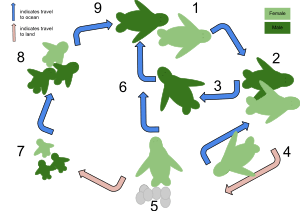
It takes decades for sea turtles to reach sexual maturity. Mature sea turtles may migrate thousands of miles to reach breeding sites. After mating at sea, adult female sea turtles return to land to lay their eggs.
The mature nesting female hauls herself onto the beach, nearly always at night, and finds suitable sand in which to create a nest. Using her hind flippers, she digs a circular hole 40 to 50 centimetres (16 to 20 in) deep. After the hole is dug, the female then starts filling the nest with her clutch of soft-shelled eggs. Depending on the species, a typical clutch may contain 50–350 eggs. After laying, she re-fills the nest with sand, re-sculpting and smoothing the surface, and then camouflaging the nest with vegetation until it is relatively undetectable visually. The whole process takes 30 to 60 minutes. She then returns to the ocean, leaving the eggs untended.
Females may lay 1–8 clutches in a single season. Female sea turtles alternate between mating in the water and laying their eggs on land. Most sea turtle species nest individually. But ridley sea turtles come ashore en masse, known as an arribada (arrival). With the Kemp's ridley sea turtle this occurs during the day.
Sea turtles have temperature-dependent sex determination, meaning the developing baby sea turtle's sex depends on the temperature it is exposed to. Warmer temperatures produce female hatchlings, while cooler temperatures produce male hatchlings. The eggs will incubate for 50–60 days. The eggs in one nest hatch together over a short period of time. The baby sea turtles break free of the egg shell, dig through the sand, and crawl into the sea. Most species of sea turtles hatch at night. However, the Kemp's ridley sea turtle commonly hatches during the day. Sea turtle nests that hatch during the day are more vulnerable to predators, and may encounter more human activity on the beach.
Larger hatchlings have a higher probability of survival than smaller individuals, which can be explained by the fact that larger offspring are faster and thus less exposed to predation.
Diet
The loggerhead, Kemp's ridley, olive ridley, and hawksbill sea turtles are omnivorous their entire life. Omnivorous turtles may eat a wide variety of plant and animal life including decapods, seagrasses, seaweed, sponges, mollusks, cnidarians, Echinoderms, worms and fish. However, some species specialize on certain prey.
The diet of green sea turtles changes with age. Juveniles are omnivorous, but as they mature they become exclusively herbivorous. This diet shift has an effect on the green sea turtle's morphology. Green sea turtles have a serrated jaw that is used to eat sea grass and algae.
Leatherback sea turtles feed almost exclusively on jellyfish and help control jellyfish populations.
Hawksbill sea turtles principally eat sponges, which constitute 70–95 % of their diets in the Caribbean.
Predators
Most sea turtle mortality happens early in life. Sea turtles usually lay around 100 eggs at a time, but on average only one of the eggs from the nest will survive to adulthood. Raccoons, foxes, and seabirds may raid nests or hatchlings may be eaten within minutes of hatching as they make their initial run for the ocean. Once in the water, they are susceptible to seabirds, large fish and even other sea turtles.
Adult sea turtles have few predators. Large aquatic carnivores such as sharks and crocodiles are their biggest threats; however, reports of terrestrial predators attacking nesting females are not uncommon. Jaguars have been reported to smash into sea turtle shells with their paws, and scoop out the flesh.
While many of the things that endanger sea turtles are natural predators, increasingly many threats to the sea turtle species have arrived with the ever-growing presence of humans.
Relationship with humans
Sea turtles are caught worldwide, although it is illegal to hunt most species in many countries. A great deal of intentional sea turtle harvests worldwide are for food. In England during the 1700s, Sea Turtles were consumed as a delicacy to near extinction, often as turtle soup. Ancient Chinese texts dating to the 5th century B.C.E. describe sea turtles as exotic delicacies. Many coastal communities around the world depend on sea turtles as a source of protein, often harvesting several sea turtles at once and keeping them alive on their backs until needed. Coastal peoples gather sea turtle eggs for consumption.
To a much lesser extent, some species are targeted for their shells. Tortoiseshell, a traditional decorative ornamental material used in Japan and China, comes from the carapace scutes of the hawksbill sea turtle. Ancient Greeks and ancient Romans processed sea turtle scutes (primarily from the hawksbill sea turtle) for various articles and ornaments used by their elites, such as combs and brushes. The skin of the flippers is prized for use as shoes and assorted leather goods. In various West African countries, sea turtles are harvested for traditional medicinal use.
The Moche people of ancient Peru worshipped the sea and its animals. They often depicted sea turtles in their art.
Beach towns, such as Tortuguero, Costa Rica, have transitioned from a tourism industry that made profits from selling sea turtle meat and shells to an ecotourism-based economy.
In other parts of the world where sea turtle breeding sites are threatened by human activity, volunteers often patrol beaches as a part of conservation activities, which may include relocating sea turtle eggs to hatcheries, or assisting hatching sea turtles in reaching the ocean. Locations in which such efforts exist include the east coast of India, São Tomé and Príncipe, Sham Wan in Hong Kong, and the coast of Florida.
Conservation status and threats
Sea turtles in all types are being endangered by the way humans use plastic. Sea turtles eat plastic bags because they confuse them with their actual diet, jellyfish, algae and other components. Plastic can clog their intestines and cause internal bleeding which will eventually kill them.
Climate change may also cause a threat to sea turtles. Since sand temperature at nesting beaches defines the sex of a sea turtle while developing in the egg, there is concern that rising temperatures may produce too many females.
The IUCN Red List classifies three species of sea turtle as either "endangered" or "critically endangered". An additional three species are classified as "vulnerable".
All populations of sea turtles that occur in United States waters are listed as threatened or endangered by the US Endangered Species Act (ESA). The US listing status of the loggerhead sea turtle is under review as of 2012.
| IUCN Red List | United States ESA* | |
|---|---|---|
| Green | Endangered | Endangered: populations in Florida and Pacific coast of Mexico populations
Threatened: all other populations |
| Loggerhead | Vulnerable | Endangered: NE Atlantic, Mediterranean, N Indian, N Pacific, S Pacific populations
Threatened: NW Atlantic, S Atlantic, SE Indo-Pacific, SW Indian populations |
| Kemp's ridley | Critically endangered | Endangered: all populations |
| Olive ridley | Vulnerable | Endangered: Pacific Coast of Mexico population
Threatened: all other populations |
| Hawksbill | Critically endangered | Endangered: all populations |
| Flatback | Data deficient | N/A |
| Leatherback | Vulnerable | Endangered: all populations |
*The ESA manages sea turtles by population and not by species.
Interesting facts about Sea turtle
- Fossil evidence of marine turtles goes back to the Late Jurassic (150 million years ago).
- Sea turtles spend a majority of their time underwater, so they must be able to hold their breath for long periods.
- A foraging sea turtle may typically spend 5–40 minutes underwater while a sleeping sea turtle can remain underwater for 4–7 hours.
- Cold-stunning is a phenomenon that occurs when sea turtles enter cold ocean water (7–10 °C (45–50 °F)), which causes the turtles to float to the surface and therefore makes it impossible for them to swim.
- Six of the seven sea turtle species, all but the flatback, are present in U.S. waters, and are listed as endangered and/or threatened under the Endangered Species Act
Images for kids
-
"Manner in which Natives of the East Coast strike turtle". Near Cooktown, Australia. From Phillip Parker King's Survey. 1818.
-
Sea turtles on a beach in Hawaii
-
Legal notice posted by a sea turtle nest at Boca Raton, Florida
See also
 In Spanish: Chelonioidea para niños
In Spanish: Chelonioidea para niños


